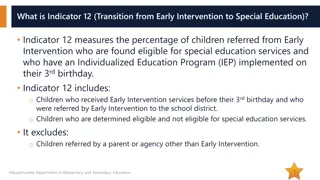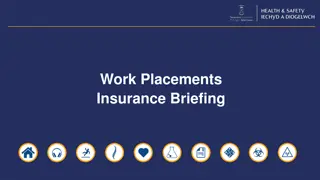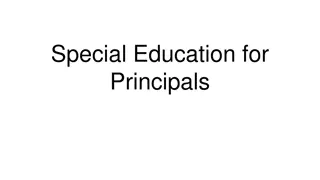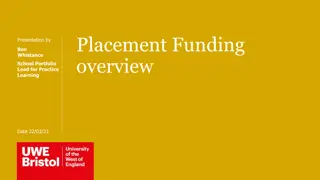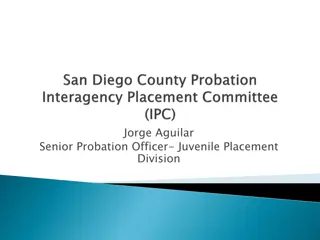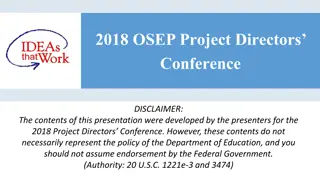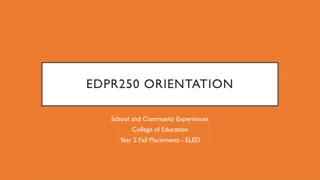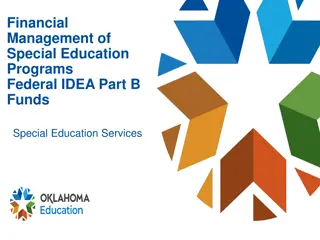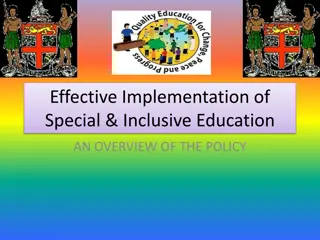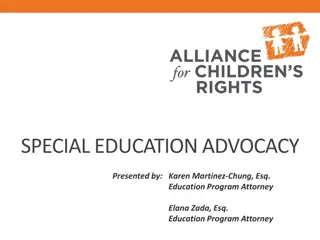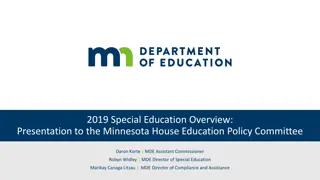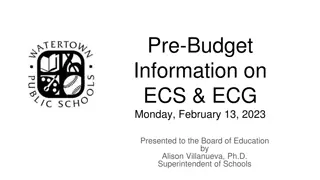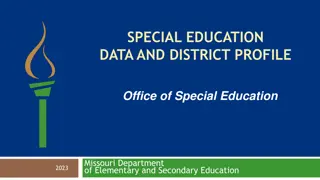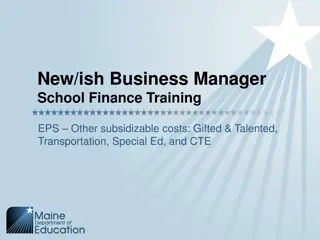Making Educationally Appropriate Placements in Special Education
Explore the importance of making educationally appropriate and legally sound placement decisions in special education, ensuring Free Appropriate Public Education (FAPE) is provided in compliance with the Individualized Education Program (IEP) and the Least Restrictive Environment (LRE). Dive into the complexities of determining suitable placements for children with disabilities while considering the individualized needs to foster inclusivity and effective learning environments.
Download Presentation

Please find below an Image/Link to download the presentation.
The content on the website is provided AS IS for your information and personal use only. It may not be sold, licensed, or shared on other websites without obtaining consent from the author. Download presentation by click this link. If you encounter any issues during the download, it is possible that the publisher has removed the file from their server.
E N D
Presentation Transcript
Making Educationally Appropriate and Legally Sound Placement Decisions Indiana IEP Resource Center Special Education Law Conference August 24 & 25, 2021 Mitchell L. Yell University of South Carolina myell@sc.edu
What I Will Do Today FAPE & placement Placement Requirements of the IDEA LRE & the courts Errors in Determining Placement Making Educationally Appropriate & Legally Sound Placement Decisions
We are concerned that children with handicapping conditions be educated in the most normal possible and least restrictive setting, for how else will they adapt to the world beyond the educational environment, and how else will the nonhandicapped adapt to them? Senator Robert T. Stafford, Congressional Record, May 20, 1974
The foundational premise is that a student s placement must be an individualized determination and made in compliance with the LRE mandate
Free Appropriate Public Education & Placement
Special education & related services that are: Provided at public expense Meet the standards of the SEA Includes preschool, elementary, or secondary education Are provided in conformity with the individualized education program (IEP) Free Appropriate Public Education (FAPE) IDEA, 20 U.S.C. 1401 (A)(18)
1. The IEP team must determine FAPE and then what placement in which FAPE can be provided. 2. There is no one-size-fits-all approach to educating children with disabilities. Rather, placement decisions must be individualized and made consistent with a child s IEP. 3. Placement in regular classes may not be the least restrictive placement for every child with a disability. LEA must ensure that a continuum of alternative placements is available to meet the needs of children with disabilities How Does the Endrew F. Decision Affect Placement? U.S. Dept. of Education 12/7/2017 Question 17
Placement Requirements of the IDEA
A team of knowledgeable persons including a student s parents, who are knowledgeable about the student, the meaning of the evaluation, and the placement options, determine the student s placement (34 CFR 300.116(a)(1)(2006). The placement decision is almost always made by the IEP team, although that is not a legal requirement Placement Requirements
The placement decision must be made at least annually and on an individualized basis. Placement Requirements Placement must be based on a student s IEP (34 CFR 300.116(b)(2)(2006).
Students with disabilities should be educated in the school that the student would attend if he/she was not disabled unless the student s IEP requires some other arrangement (34 CFR 300.116(a)(b)(c) 2006). Placement Requirements
When placing students, considerations must be given to any potential harmful effects on teaching and learning of the student or his/her peers Placement Requirements Before making such a determination, the team must ensure that consideration has been given to the full range of supplementary aids and services that could be provided to accommodate the student in the general class (Federal Register, 34 CFR 300.11646589
Placement must be made in the least restrictive environment (LRE) Placement Requirements LRE refers to the educational setting closest to the general classroom in which the student can receive a free appropriate public education (FAPE)
1. To the maximum extent appropriate, students with disabilities should be educated with children who are nondisabled 2. Special classes, special schooling, or other removal of children with disabilities from the general education environment should occur only if the nature or severity of the disability is such that education in the general education classroom with the use of supplementary aids and services cannot be achieved satisfactorily Least Restrictive Environment IDEA, 20 U.S.C. 1412
In providing or arranging for the provision of nonacademic and extracurricular services and activities, including meals, recess periods, and the services and activities (LEAs) must ensure that each child participates with nondisabled children in the extracurricular services and activities to the maximum extent appropriate to the needs of that child. The (LEA) must ensure that each child has the supplementary aids and services determined by the child's IEP Team to be appropriate and necessary for the child to participate in nonacademic settings. 34 CFR 300.117 LRE & Extra Curricular/Non academic Services
Continuum of Alternative Placements Least Restrictive Regular Classroom Special Classes Special Schools Hospital/Institution Most Restrictive
Resource room and itinerant instruction are viewed as supplementary services provided in supplementary aids and services provided in conjunction with general education placement (34 C.F.R. 300.115(b)(2)(2006)). Where are Resource Room Services in the Continuum?
The IEP must include an explanation of the extent, if any, to which the child will not participate with nondisabled children the regular class and in (extracurricular and nonacademic) activities 20 U.S.C. 1414(d)(1)(A)(iv)(2006). Explanation in the IEP
A student with a disability may not be removed from an age- appropriate general education classroom solely because of modifications needed to the general curriculum 34 CFR 300.116(e)(2006). Removal from General Ed
LRE Tests Roncker Test Daniel Test No Standard Roncker Test Rachel H. Test Daniel Test No Standard Roncker/Devries Test Daniel Test Daniel Test Daniel Test
The Act does not require mainstreaming in every case but its requirement that mainstreaming be provided to the maximum extent appropriate indicates a very strong congressional preference. The proper inquiry is whether a proposed placement is appropriate under the Act. In a case where the segregated facility is considered superior, the court should determine whether the services which make that placement superior could be feasibly provided in a non-segregated setting. If they can, the placement in the segregated school would be inappropriate under the Act. L.H. v. Hamilton County Department of Education (6th Cir. 2018) Roncker v. Walter 700 F.2d 1058 (6th Cir. 1983)
1. Has the school attempted to accommodate the student by providing sufficient supplementary aids and services and sufficient program modifications in the regular education setting? 2. If the student cannot be accommodated in the regular classroom setting, has the school mainstreamed the student to the maximum extent appropriate? Daniel R.R. v. State Board of Education 874 F.2d 1036 (5th Cir. 1989)
Facts of the Case: Beth was a 13-year-old girl with Rett Syndrome (non-verbal, little mobility) From age 7 to 13 she was served in a regular classroom with a paraprofessional and special curriculum At age 13, the IEP team recommended that Beth be placed in an Educational Life Skills (ELS) program Program was located in a different school with 6 to 8 students, student-teacher ratio of one-to-one, and mainstreaming of computer, recess, social studies Reverse mainstreaming program Parents disagreed Beth B. v. Van Clay 282 F.3d. 493 (7th Cir. 2002)
Each students educational situation is unique. We find it unnecessary at this time to adopt a formal test for district courts to apply uniformly when deciding LRE cases. The law itself provides enough of a framework for our discussions. The 7th Circuit s No Test Test Instead, we ask whether the education in the conventional school was satisfactory and, if not, whether reasonable measures would have made it so.
THE LEA made good faith attempts at included the student in regular education Parents were involved in the process LEA maintained excellent documentation Students were education in integrated settings whenever appropriate Why Did LEAs Prevail?
LEAs failed to make good faith efforts to provide accommodations to keep the student in the regular education classroom LEAs failed to consider the full continuum of placements LEAs did not maintain sufficient documentation of their efforts Why Did LEAs Lose?
Errors in Determining Placement
Placing Students for Reasons Unrelated to Students Individual Needs
Letter to Cohen, The law requires that "first consideration" must be given to placement in a regular classroom with any necessary supplemental aids and services to make that placement successful before considering more restrictive placement options. 1996 (25 IDELR 516, OSEP)
In response to the proposed establishment of a series of segregated charter schools for students with autism in a New Jersey school district, OSERS noted that these schools would violate the IDEA because placements that are determined based solely on the category of a child's disability are not consistent with the regulations. Letter to Autin, 1996 (25 IDELR 2012, OSEP)
Placement decisions must not be made solely on factors such as category of disability, severity of disability, availability of special education and related services, configuration of the service delivery system, availability of space, or administrative convenience. Letter to Trigg, 2007 (50 IDELR 148, OSEP)
Failing to adhere to the Continuum of Alternative Placements.
A student with a disability need not fail in the regular education environment before a local educational agency can consider or implement a placement in a more restrictive setting. OSEP Policy Letter, 1997 (25 IDELR 1211, OSEP)
Education Achievement Authority of Michigan, The parents prevailed with State ruled that the school district s contention that full inclusion was the only option available violated the IDEA. The regulation to the IDEA require that districts ensure the availability of a continuum of placements to students with disabilities, 2014 (15 LRP 63, SEA, MI)
Error: Predetermining Students Placements
Predetermination occurs when an educational agency has made it s determination prior to the IEP meeting, including when it presents one placement option at a meeting and is unwilling to considerother alternatives. H.B. v. Las Virgenes (239 Fed. Appx. 342, 9th Cir. 2007)
Preparation for an IEP meeting by school district personnel would not result in a finding of predetermination when school personnel are committed to allowing a student s parents an opportunity to meaningfully participate in the process. Preparation v Predetermination
T.P. v. Even if there was such discussion, this does not mean the parents were denied meaningful participation at the IEP meeting. IDEA regulations allow school districts to engage in preparatory activities Mamaroneck S.D. (554 F3d. 247, 2nd Cir. 2009)
School officials must come to the IEP table with an open mind. But this does not mean that they should come with a blank mind Doyle v. Arlington (E.D.VA 1992)
Placing a student prior to Placing a student prior to determining determining programming programming
The IDEA presumes that students will participate with nondisabled students in general education settings The IEP must be developed before placement decision Include supplementary aids & supports, program modifications, positive behavioral supports & interventions in general education settings Placement
Shoehorning: Deciding placement prior to determining annual goals and special education services, thus shaping a student s IEP to fit a particular placement A student s educational placement must be based on the child s IEP (34 C.F.R. 300.116(b)(2)) Avoid shoehorning by not considering placement issues until the goals & services section of the IEP has been completed Avoid Shoehorning
Placement determined prior to the development of the child's IEP and without parental input was a per se violation of the Act and sufficient to constitute a denial of FAPE in and of itself Spielberg v. Henrico County (4th Cir. 1991)
You can plan but dont finalize Avoid statements or emails that could be used to prove predetermination Emphasize to parents that placement decisions are based on a student s individualized needs Demonstrate that parent s information & concerns were incorporated into the IEP Make the placement determination at the end of the meeting Avoiding Predetermination
Making Educationally Appropriate & Legally Sound Placement Decisions
Special Education Process The Right Way Programming Placement Assessment Bateman & Linden, 2012
Special Education Process Shoehorning Programming Placement Assessment Bateman & Linden, 2012
Placement Flowchart Determine FAPE Measurable annual goals Special education services Progress-monitoring system Determine Appropriate Placement In what placement may FAPE be delivered Can FAPE be achieved via supplementary aids & services If no, move through the continuum to determine LRE ProvideIntegrated Experiences


















